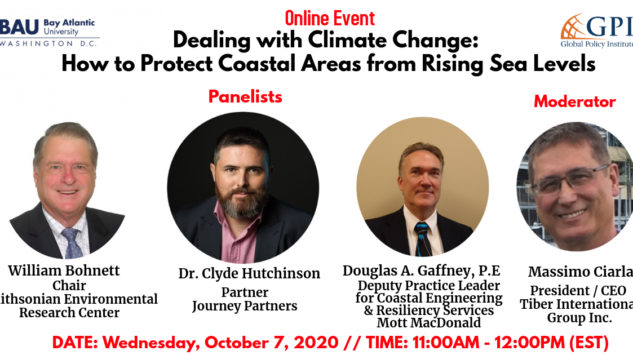Events

ONLINE EVENT // Dealing with Climate Change: How to Protect Coastal Areas from Rising Sea Levels
On Wednesday October 7, 2020, at 11:00AM (EST) The Global Policy Institute and Bay Atlantic University hosted a webinar titled:
“Dealing with Climate Change: How to Protect Coastal Areas from Rising Sea Levels”
Global warming is already causing extensive melting of polar ice. This means progressively higher sea levels, and therefore a growing direct threat of flooding for cities large and small, such as Miami, Barcelona or Mumbai, located in coastal areas all around the world. Public policy specialists, urban planners and engineers are already busy looking at practical countermeasures (seawalls, dams, highways elevation and more) aimed at mitigating the impact of this potentially catastrophic climate change related development. And this is only the beginning.
Gaffney opened the discussion by pointing out that it is easy to keep track of rising sea levels. This highly disruptive phenomenon is real, observable and measurable. We should all be concerned when noticing that sea levels have been rising at a more rapid pace in recent years on account of the melting of polar ice caused by global warming. Bohnett added that many experts are engaged in both gathering all the available knowledge and disseminating it. Their studies go into academic journals. But much is also done to spread this alarming information in order to educate the general public about the threat mankind is facing. One important focus area is Blue Carbon. The term refers to special ecosystems existing in coastal areas that do a great job in absorbing carbon, while protecting coastlines from the advancing sea. Hutchinson pointed out that this challenge needs the full engagement of people living in coastal communities. Rising sea levels are and will be disruptive. The people who live in coastal areas need to preserve their cities and towns. Many are engaged in the tourism business that will be disrupted by severe damage to the coastline caused by rising sea levels. The focus should be on long term sustainable solutions. This can be done through adaptation measures. Gaffney added that much is already being done to protect coastline infrastructure. Some of it is by nurturing natural protective barriers such as marshland and mangroves. Engineers already design infrastructure that will not be affected by future higher sea levels.
Bohnett recognized that it is very difficult to move from agreement among scientists to timely action directed by policy-makers. Hutchinson added that bottom up community action is a more promising approach. Get the people directly affected involved. Engage communities, businesses, universities, in order to come up with creative solutions that will protect settlements and build resilience. Gaffney pointed out that in New Jersey one particular community had invested substantial resources in enhancing the resilience of critical infrastructure such as electric equipment. When a hurricane struck, things kept working. Pumps were operating. Because of these investments, getting back to normal was faster than elsewhere. Given a deteriorating future scenario, it is critical to design new systems and infrastructure keeping in mind the threat of higher and higher sea levels. Prepare for the worst conditions. Bohnett stressed that this is absolutely essential. Within a few decades, millions of people will be underwater at high tide. Miami is already planning to raise its highways now. Huge sums have been allocated.
Hutchinson pointed out that in Europe there is an effort underway aimed at encouraging entrepreneurs to share their ideas and innovations in order to come up with a new body of best practices when it comes to dealing with the impact of higher sea levels. Gaffney added that we are dealing more and more with “blue skies and sunny days” –that is floods caused not by extreme weather but by rising high tides. Designers have to evaluate this dangerous trend in everything they plan. Risks are growing, and so are the costs of more resilient infrastructure. Hutchinson concluded by stating he is optimistic about the power of bottom up community initiatives. Human ingenuity will face this threat and beat it. Bohnett wrapped up the panel discussion by stating that the disruption –present and future– caused by rising sea levels may very well be the worst consequence of global warming.